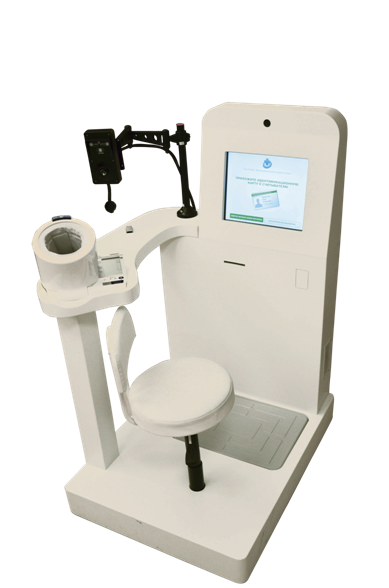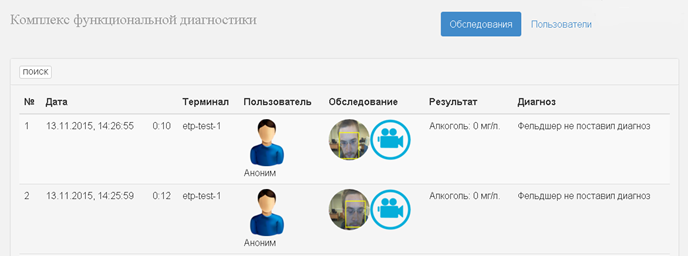Diagnostic terminals for real welders

In many hazardous industries must be a doctor. Or, to send the bus driver to the flight, you need to see a doctor at the bus station. Or, in order for the pilot to fly the flight, you need to pass a whole commission. In order for the dispatcher of a nuclear power plant to take over, you need to make sure that it is not under drugs, not in a heavy hangover and not drunk. And so on.
In many factories, these rules apply to ordinary employees. A lot of them. But their inspection is simpler than that of a pilot or an NPP dispatcher. They can measure temperature, pressure, pulse, oxygenation (the level of oxygen in the blood), basic reflexes, the level of alcohol. Somewhere standards forbid robots to diagnose this set of parameters, and somewhere they are allowed to measure, but their measurement must be certified by a doctor. That is, a living person is not excluded from the process, but his work can be very automated.
')
We have put together a collection of all these indicators so that in the morning, when real welders come to work, they do not have to stand in line.
But the devil, of course, is in the details. Although, after tests of the breathalyzer, there is little concern in this mortal world.
What is a functional diagnostic complex?
This is a Linux machine to which various medical sensors are connected. On top of the operating system, application software is installed in the terminal mode, which is able to authenticate patients by card, finger, face or eye, run them through tests and enter the results into the database. Also results can be printed. The database can be located both inside the device itself and in the organization’s HR system or on a third server. Often, the functional diagnostics complex is combined with other subsystems of the company - for example, if the patient is “not all” in the breathalyzer, then caring guards take him to sleep. Or he can not then log in to the workplace without such verification. Or can not pass through the turnstile.
It looks like this:

In the basic configuration, this is a case, an anti-vandal SAW-touchscreen (16 mm glass), a printer for results, a camera for communicating with a doctor or checking that the patient has not changed after authentication. From the sensors, the pulse meter and the level of oxygen in the blood are finger-tight, an automatic pressure gauge (a tire for a hand), and a breathalyzer. In the extended configuration, pupillometer is added (it determines the adequacy and fatigue, I told about it in detail here ), a contactless thermometer, scales and any other sensors: you can put a meter, a contact thermometer, and so on. For example, body mass indexes are very popular in the USA - this is something like an ohmmeter.
All that can be removed from the data can be connected to the terminal. It will be necessary to put an autodocument of the Brotherhood of Steel - we will install it, just describe its API and give one to the tests.

The first three sensors are included in the basic configuration, scales - optional
Naturally, if each sensor individually works normally, then this does not mean that together they will work well.
Basic sensors
The breathalyzer is a device consisting of an ethyl alcohol sensor, or rather, its vapor in the air, and a bundle with an access control system. If the patient is okay, the turnstile opens. If alcohol is found in the blood - the message is protected, and the turnstile does not open.
Installing such a terminal, even in a turnstile, does not cancel the medical personnel at the enterprise, but it can significantly reduce the load on it. And reduces the influence of the human factor on the objectivity of the testimony - this is when the "good" protection misses the "good" workers.

Wall-mounted version of the terminal with breathalyzer and face and map authentication
An oxygenation sensor (pulse oximeter) is needed to measure the pulse and the level of blood oxygen saturation. What is it for? If the patient is sick, the changes are visible by pressure and pulse. Usually. But there are a number of cases where the pulse oximeter allows you to get a diagnosis earlier. An asthma attack, carbon dioxide poisoning or a series of gases, a pre-infarction condition - all this can be determined.
Additional sensors
The thermal imager is familiar to everyone, and at its base we decided to make a non-contact thermometer. Why? Because we know that many countries under quarantine control look at the stream of arriving guests of the country from an airplane just through a thermal imager. Some take more warm.
They decided to measure the temperature on the forehead, because it is easy to find and easy to present. Right above the place where you have to breathe, there is a point temperature sensor (this is something like a single-pixel thermal imager). Our tester quickly learned to deceive the terminal, rubbing his forehead before measuring: the terminal immediately sounded the alarm and offered to call the ambulance, the quarantine control team and the sweep squad.
About pupillometer: if very short, it measures the time of the reaction of the pupil to the light of a certain wave, which allows you to forward ping to one of the nerve centers in the brain. Flash - then the response time is measured. By the speed of arrival of the package, you can set the approximate state of the nervous system. Specifically - are there any moderators or wild boosters on the road. These are usually illnesses, alcohol, drugs, medicines, fatigue, drowsiness, or a psychiatric diagnosis.
Tests
In production, where there was a second branch of tests, another problem arose: we did not think that the human body could be cooled so much. That is, workers in the chemical industry outside the Arctic Circle, coming from the street, showed on the skin a temperature that was noticeably beyond the parameters that we, swept away by Moscow, were considered normal.
Since the contact thermometer is deceived in a similar way, you still need at least an evil nurse who is monitoring the patient. It is assumed that the doctor normalizes the patients before the measurement, that is, does not allow the forehead to be applied immediately from the frost and makes sure that they do not chemically. Since in this project we are not doing a completely autonomous system, we are automating the work of the doctor (he confirms the results and inspects the mucous membranes), this is normal.
Next came the tests of pupillometer and breathalyzer.
Testers offered us this idea: to let them drink at work. And they began to test other applications. That is, a day without sleep a couple of times, energy, check a sudden loading dose of alcohol, and so on. Then they took him to a music festival, which enriched the research. Even in highly altered states of consciousness, testers found new and new ways to deceive the system.
We all closed these vulnerabilities. In particular, the breath of breath from the breathalyzer was a particularly steep story. Even if you are drunk as a lanyard, then the past generation of devices said that you were “glass like a soothbeast.” In the new generation appeared control the direction of air flow.
Here is what the security guard, who controls the inspection, brought us from production:
There are several solutions besides the security guard: changing the contour of the face on the video, reconciling history studies (usually breathe first, then come with a pear), plus the security itself highlights the most malicious ones and watches the video.
Soft
Further, in fact, it was not so enchanting. A week of intercourse with the printer so that it prints immediately and into the hands of the patient, and if it cannot, it would destroy the print task. Then there is a long integration with ACS, so that the information of the feldscher is available. We tested the video link (it did not go to the series) - well, yes, telemedicine can be, but there is no need. Now just write a video survey process. Doctors often need non-trivial things. Well at least here the exact color of the blood did not require (this is very important for surgeons with teleaccess).
I checked the authentication on the iris: it already photographs the pupillometer, but there were no tests with cut out eyes either. Bad luck.
Then there is a long history with PD storage: we have a whole department that can do secure storage both in one terminal and within the system. Clearly, the stringent IS requirements have not diminished our work.
Made web access to the server:

You can see the results of surveys completed by users, select all one by one, or select the TOP-10 alcoholics of the plant. Configure the mailing of various mail notifications to interested persons in case of critical deviations of the user's medical indications from the norm. Build reports on surveys completed for any period / at certain terminals / defined by users.
Total
The result is a finished terminal.
Medical terminal - for example, this is Intel Celeron G1620 @ 2.70GHz, 2 GB RAM, 60 GB SSD, Linux OS. Intel Xeon E5620 @ 2.40GHz, 16 GB RAM, 2 TB HHD Servers. The terminals are equipped with an internal UPS, anti-vandal screen and housing, contactless access card reader to identify the subject, the printer.

Full examination session - 3 minutes (with additional sensors - more).
Doctors concluded that the medical terminal can quickly detect the signs of a hypertensive crisis in the patients, threatening the development of myocardial infarction and stroke, heart rhythm disturbances, accompanied by an increase in pulse rate (tachycardia) or its decrease (bradycardia), feverish states: manifestations of acute infections (ORVI, flu), alcohol intoxication. What could be without him in the factory.
In general, it turns out a real “designer” from which you can assemble a convenient and functional complex of express diagnostics. Even the body, you can choose any.
Pilot implementation of the full complex was at the federal energy company. Medical terminals are used for daily check-ups of employees taking over. Employee identification takes place in three stages: using an individual USB key, photo recognition and fingerprinting. Comprehensive diagnostics includes measuring blood pressure, pulse rate and breathing for the content of alcohol vapors.
According to the results of another implementation, the customer noted that “the use of terminals for daily pre-shift inspections helps reduce the risks of industrial injuries and accidents, as well as strengthen team discipline.”
Some enterprises have implemented a single point of passage system. The terminals installed at the gateways are used to examine employees before and after the shift. This is an evolution of the wall version, which is placed in the turnstiles. A hard worker cannot go to his home plant unless he embraces the terminal. 12 seconds - went further, and a record of the time of passage fell into the database, with authorization and inspection status - into the base of medical observation.
We had an introduction for 15 thousand users, 12 thousand passes through the turnstile per day. In a year and a half, 1,223 employees were found intoxicated.
Links
- Pupillometer
- My mail is medkiosk_info@croc.ru
Source: https://habr.com/ru/post/424501/
All Articles